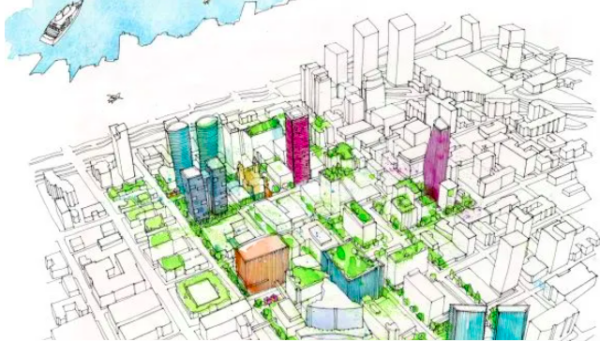
SEATTLE — The Archdiocese of Seattle and its St. James Cathedral will sell and redevelop four properties in the city’s First Hill neighborhood as part of a project that aims to create affordable housing and steer the neighborhood towards carbon neutrality.
“Creatively thinking about how we can better use our properties to achieve the mission of the church is exactly what we need to do as good stewards of God’s gifts,” Archbishop Paul Etienne of Seattle said in a statement. “Redeveloping our real estate in a very efficient and sustainable way not only reflects our Catholic value for our common home but also provides us with resources to carry out our greater mission of bringing Christ to others.”
The archdiocese will sell and redevelop the properties with developer Westbank.
Westbank and its affiliate Creative Energy, meanwhile, have partnered with Swedish Health Services to modernize the Seattle area health care system’s infrastructure with a goal of being carbon negative by 2030. Creative Energy is a North American district energy provider.
As part of the project, Swedish will be able to divert excess heat from its First Hill Campus to a new energy-sharing platform, which will include the diocesan buildings. The energy-sharing platform will turn that excess heat into a heating source for other buildings in the First Hill community connected to the platform, which those involved say will “drastically” reduce the carbon footprint of the entire neighborhood. The First Hill neighborhood is just east of downtown Seattle.
“Recognizing all of nature as the handiwork of God, Pope Francis calls us to do all we can to protect the earth from further destruction,” Archbishop Etienne said. “Minimizing our impact on the earth is our responsibility as Catholics. Working with sustainability experts like Westbank and Creative Energy will ensure that the redevelopment uses green building techniques, processes, and materials while alleviating future environmental impacts.”
The four buildings the archdiocese will sell and redevelop include the St. James Cathedral Pastoral Outreach Center, its old chancery building, and the historic Connolly House, which will be preserved as part of the agreement with Westbank, according to a joint news release from the parties involved.
As part of the redevelopment of the buildings, Westbank plans to create upwards of 1,300 residential homes that will be connected to this new district energy system. The redevelopment plan could also generate over $25 million for Seattle’s Mandatory Housing Authority fund, according to the news release. This money would go to low-income and affordable housing buildings including Catholic Housing Services.
Ian Gillespie, the founder of Westbank, said the initiative will create “low-carbon housing, infrastructure, and amenities that will serve Seattle for generations to come.”
“We’re looking forward to continuing our work with the Archdiocese of Seattle and the team at Swedish Health Services to not only contribute to the long-term vitality of this community but help First Hill significantly reduce its carbon footprint and demonstrate leadership globally in responding to climate change,” Gillespie said in a statement.
The need to reduce carbon emissions and enact greater environmental policies and initiatives has been an emphasis of Pope Francis’ pontificate. It was the focus of his 2015 encyclical Laudato Si’, subtitled “On Care for Our Common Home.”
In December 2020, Pope Francis committed the Vatican to net-zero carbon emissions by 2050. The United States Conference of Catholic Bishops in 2017 called on the United States to do the same, and last year applauded President Joe Biden’s commitment to reaching that goal.
In the years since the encyclical, a number of individual U.S. dioceses have also committed themselves to the vision of Laudato Si’ through different local initiatives — the efforts by the Archdiocese of Seattle being the latest.
There’s confidence in the Archdiocese of Seattle that the move to sell and redevelop the four properties will benefit the diocese’s workforce structure as well.
Joe Schick, the chief financial officer for the archdiocese, noted in a statement that archdiocesan employees are currently split between four buildings, “which is not only costly to maintain but also inefficient and an impediment to collaboration among archdiocesan staff.”
With this move, the plan is to merge all 125 employees into one office building. St. James Cathedral — dedicated in 1907 and home to 2,400 Catholics — will relocate the offices and meeting areas that are currently housed in the Pastoral Outreach Center.
“This redevelopment will allow us to improve our office and gathering spaces, while greatly enhancing our ability to carry out our mission of worship and service,” Father Michael Ryan, pastor of the cathedral since 1988, said in a statement.
